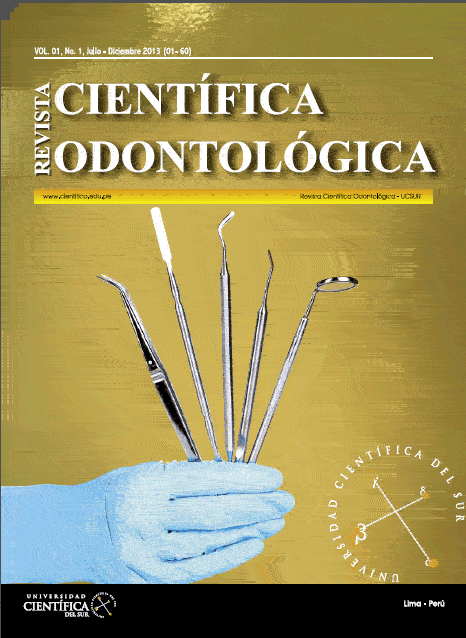Colapso posterior de mordida: etiología, diagnóstico diferencial y tratamiento
DOI:
https://doi.org/10.21142/2523-2754-0101-2013-%25pKeywords:
Oclusión Dental, Colapso Posterior de MordidaAbstract
El propósito de esta revisión de reportes de caso y de la literatura es informar al odontólogo general y especialista sobre un correcto significado del diagnóstico del colapso posterior de mordida, y por ende su tratamiento, ya que al tener múltiples conceptos guiará a diferentes enfoques, lo cual resulta confuso. Esta situación clínica implica una pérdida de la dentición en el sector posterior lo que conlleva a una sobrecarga anterior, este signo en algunos casos lleva a perder la correcta oclusión. Existen otras posibles causas para este desorden de la oclusión, como la enfermedad periodontal, alteraciones en forma y función de labios y lengua, así como maloclusiones y hábitos parafuncionales. La variedad del diagnóstico diferencial se ejemplifica con 4 casos clínicos. Finalmente, se da una guía del manejo clínico del odontólogo con respecto a esta alteración.
Downloads
References
Craddock HL, Youngson C, Manogue M, Blance A. Occlusal changes following posterior tooth loss in adults. Part 1: A study of clinical parameters associated with the extent and type of supraeruption in unopposed posterior teeth. J Prosthodont. 2007;16(6):485-94.
Craddock HL, Youngson C, Manogue M, Blance A. Occlusal changes following posterior tooth loss in adults. Part 2: Clinical parameters associated with movement of teeth adjacent to the site of posterior tooth loss. J Prosthodont. 2007;16(6):495-501.
Craddock H. Occlusal changes following posterior tooth loss in adults. Part 3: A study of clinical parameters associated with the presence of oclusal interferences following posterior tooth
loss. J Prosthodont. 2008;17:25-30.
Salzman J. A study of orthodontic and facial changes of effect on dentition attending the loss of first molar in five hundred adolescents. JADA. 1938; 25:892.
Erlich J, Jaffe A. The effect of first molar loss on the dentition and the periodontium. J Prosthet Dent. 1983; 50:830.
Amsterdam M, Abrams L. Periodontal therapy. 5ta edition. St. Louis: CV Mosby Co. 1968. Chapter 6, Periodontal prosthesis; p.527.
Ramfjord S, Ash M. Occlusion. St. Louis: CV Mosby Co. 1966.
Stern N, Brayer L. Collapse of the occlusion-aetiology, symptomatology and treatment. J Oral Rehab. 1975;2:1
Battistuzzi P, Kayser A, Peer P. Tooth loss and remaining occlusion in a Dutch population. J Oral Rehab.1987;14:541-7.
Marcus SE, Drury TF, Brown LJ. Tooth retention and tooth loss in the permanent dentition of adults: United States, 1988-1991. J Dent Res. 1996;75:684-95.
Meskin LH, Brown LJ. Prevalence and pattern of tooth loss in U.S. employed adult and senior populations 1985-86. J Dent Educ. 1988;52:686-91.
Hirschfeld I. The individual missing tooth: a factor in the dental and periodontal disease. JADA. 1967; 24:67-82.
Compagnon D, Woda A. Supraeruption of the unopposed maxillary first molar. J Prosthet Dent.1991;66:29-34.
Martinez-Canut P, Magán L. A study on factors with pathologic tooth migration. J Clin Periodontol. 1997; 24:492-7.
Carranza FJr. Glickman´s Clinical Periodontolgy. Philadelphia: W.B. Saunders CO. 1990. 16. Hirschfeld I, Geiger L. Minor tooth movement in general practice. St Louis: MO. Mosby Co.1974.
Heckert L. Prerestorative therapy using a modified Hawley splint. J Prosthet Dent 1980; 43:26-30.
Marks MH. Atlas of adult orthodontics. Philadelphia: Lea and Febiger.1989.Chapter 11, Posterior bite collapse; p.466-71.
Giovanoli JL, Dersot JM. Posterior Bite Collapse (I) Etiology and diagnosis. J Periodontol.1989; 8:187-94.
Hirchsfeld I. The dynamic relationship between pathologic migration teeth and inflammatory tissue in periodontal pockets: a clinical study. J Periodontol.1983; 4:35-47.
Stephens CD. The use of spontaneous tooth movement in the treatment of malocclusion. Dent Update. 1989; 16(8):340-2.
Ambard A, Mueninghoff L. Planning restorative treatment for patients with severe malocclusions. J Prosthet Dent. 2002;88(2):200-7. Revista Científica Odontológica. 2013;1:36-43 Recibido: 16-01-13 Aceptación: 16-02-13 Autor principal: Carlos Munive Campos Correspondencia: dr.carlosmunive@yahoo.com.pe
Weinstein S. On an equilibrium theory of tooth position. Am J Orthod Dentofacial Orthop. 1963;33:1.
Proffit WR. Equilibrium theory revisited: factors influencing the position of teeth. Angle Orthodontist 1978;48(3):175-86.
Dawson P. Functional Occlusion- from TMJ to smile design. St Louis: Mosby.2007.
Downloads
Published
Issue
Section
License

Este obra está bajo una licencia de Creative Commons Reconocimiento 4.0 Internacional.












